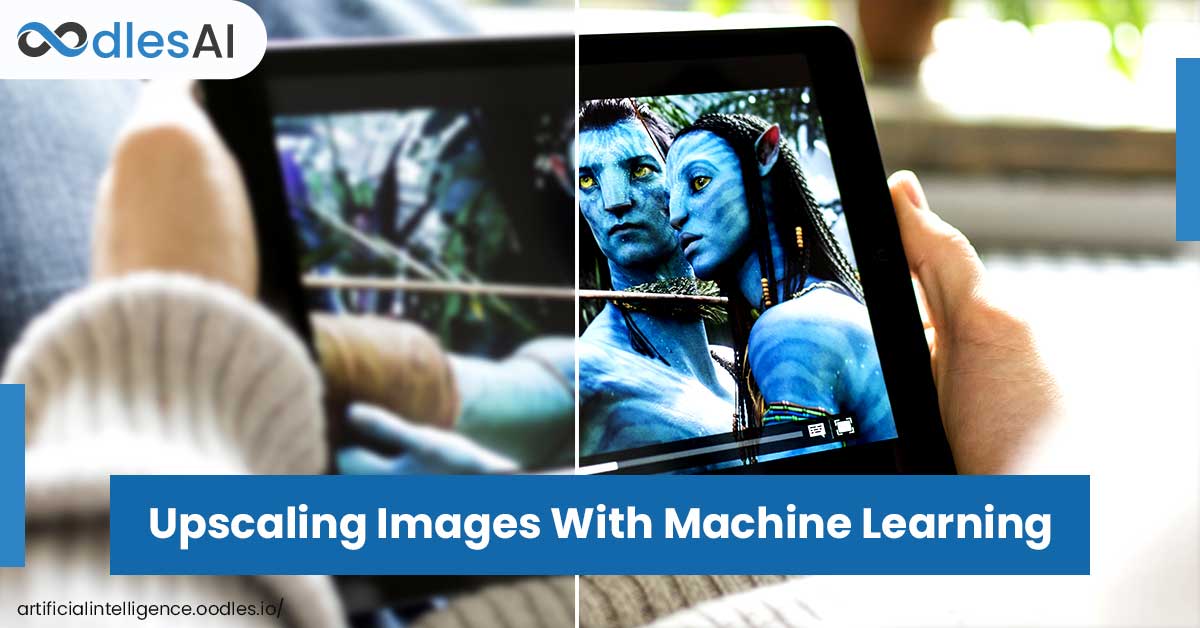Upscaling Images With Machine Learning for Optimum Resolution
Sanam Malhotra | 21st May 2020

Capturing crystal clear images can be painstaking, but not with Artificial Intelligence (AI). Backed by machine learning algorithms, AI can significantly upscale low-resolution images to perfectly fit ultra-HD, 4K, and even 8K display with minimal efforts and time. Not just video streaming but upscaling images with machine learning can greatly enhance visual content for healthcare, eCommerce, surveillance, and other businesses.
Read on to explore how providers of AI development services are channelizing the AI Upscaling technology toward innovative enterprise-grade solutions.
How Upscaling Images with Machine Learning Works
For image upscaling, machine learning employs simulated neurons or neural networks to predict a high-resolution image from a given low-resolution image. To predict an HD version of the original image, the neural network model is trained with millions of high and low-resolution images. In data science, this process is also referred to as ‘Super-resolution’.

A paper published on arXiv details the Single Image Super-Resolution framework.
Algorithmic advancements have led machine learning development services to master the pixels of visual content including images, video clips, CCTV footage, and others. For any pixelated image, the ML model can easily fill in the gaps by predicting the accurate pixel value almost instantaneously.
With machine learning capabilities, 1080p HD images can be efficiently upscaled for 4K display screens with as much as 30 frames per second in real-time.
Upscaling images with machine learning is, therefore, drastically improving the quality and speed of HD content creation for TV, video games, and other streaming services like HBO, Netflix, etc.
Traditional Upscaling Vs AI Image Upscaling With Machine Learning
Classical approaches to image upscaling struggled to maintain the quality and sharpness standards when converting a low-resolution image into a high-resolution one. The basic method called ‘Interpolation’ fills in the gap for missing pixels with either color values or repeated pixels. It makes the image turn muted or blurry due to excessive stretching of the image pixels.

Computer game company, NVIDIA visualizes how deep learning neural network preserves the fine details, edges, sharpness, and clarity of the zoomed-in original image.
Since modern TV screens and even mobile screen support a higher pixel-per-inch (PPI) ratio, conventional upscaling method fail to stretch visual content for 4k or 8k. Contrary to traditional stretching methods, upscaling with machine learning does the math to balance the pixels according to the screen size automatically. Machine learning’s ability to adjust an image’s PPI ratio is being used by various TV and desktop manufacturers from Samsung to Intel.
Let’s explore how modern businesses can deploy AI upscaling to enhance customers’ experience across the digital landscape.
Also read- Building and Deploying an AI-powered Image Caption Generator
How Enterprises are Upscaling Images with Machine Learning
1) Delivering Ultra-HD Visual Content
With spiraling demand for immersive consumer experience across offline and online channels, video streaming businesses are chasing content perfection more than ever. Upscaling images with machine learning opens great opportunities for TV broadcasting and video streaming applications to enhance viewer experience with ultra-HD visual content.
In addition to video content, AI upscaling can also be deployed for other consumer-centric services such as-
a) Optimizing product images for eCommerce platforms
b) Improving the quality of healthcare imagery such as CT scans, X-rays, etc.
c) Upscaling satellite images for better analytics
d) Enhancing online learning experiences by explaining complex subject matters with clearer images and visuals.
Also read- Copy That: Realistic Voice Cloning with Artificial Intelligence
2) Modding Video Games
While modern video games are in-built with high-resolution capabilities, a trend gaining steam among professional gamers is to restore old video games. To assist fans in upscaling old video games, machine learning algorithms are showcasing impressive tools and techniques.

From classic video games like Doom to more recent ones like Mass Effect2, AI upscaling is gaining significant traction among video game modders for creating enhanced versions.
3) Mapping Remote Locations
Another key area of application for AI upscaling is the video footage generated by CCTV cameras, sensors, and drones.
AI’s ability to upscale visual data in real-time can largely benefit surveillance operations, security checkpoints, and remote assessment to analyze video content with granular precision.
Analysts are eyeing massive potential in machine learning to cut down laborious hours of sanitizing raw footage and driving actionable insights.
Also read- AI for Video Analytics: Enterprise Applications and Opportunities
Achieve Optimum Image Resolution With Oodles AI
With the consumer digital content market growing exponentially, it is imperative to offer crystal clear visuals across devices and channels. To attain an immersive consumer experience, we, at Oodles AI, are harnessing the power of machine learning algorithms for-
a) Processing low-resolution images and videos for high-resolution display
b) Enhancing product images for eCommerce businesses
c) Improving medical imagery for better diagnosis, and more.
Our computer vision and object detection capabilities add more value to our image upscaling services with maximum quality retention and better insight generation.
To discover more about our AI upscaling and ML capabilities, connect with our AI development team of experts and data analysts.



